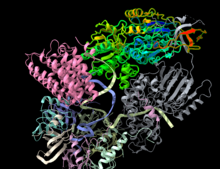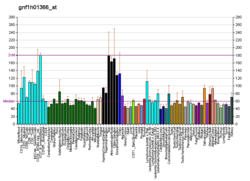Polyadenylation is the addition of a poly(A) tail to an RNA transcript, typically a messenger RNA (mRNA). The poly(A) tail consists of multiple adenosine monophosphates; in other words, it is a stretch of RNA that has only adenine bases. In eukaryotes, polyadenylation is part of the process that produces mature mRNA for translation. In many bacteria, the poly(A) tail promotes degradation of the mRNA. It, therefore, forms part of the larger process of gene expression.

The TATA-binding protein (TBP) is a general transcription factor that binds specifically to a DNA sequence called the TATA box. This DNA sequence is found about 30 base pairs upstream of the transcription start site in some eukaryotic gene promoters.

Transcriptional modification or co-transcriptional modification is a set of biological processes common to most eukaryotic cells by which an RNA primary transcript is chemically altered following transcription from a gene to produce a mature, functional RNA molecule that can then leave the nucleus and perform any of a variety of different functions in the cell. There are many types of post-transcriptional modifications achieved through a diverse class of molecular mechanisms.
Cleavage and polyadenylation specificity factor (CPSF) is involved in the cleavage of the 3' signaling region from a newly synthesized pre-messenger RNA (pre-mRNA) molecule in the process of gene transcription. In eukaryotes, messenger RNA precursors (pre-mRNA) are transcribed in the nucleus from DNA by the enzyme, RNA polymerase II. The pre-mRNA must undergo post-transcriptional modifications, forming mature RNA (mRNA), before they can be transported into the cytoplasm for translation into proteins. The post-transcriptional modifications are: the addition of a 5' m7G cap, splicing of intronic sequences, and 3' cleavage and polyadenylation.

Eukaryotic transcription is the elaborate process that eukaryotic cells use to copy genetic information stored in DNA into units of transportable complementary RNA replica. Gene transcription occurs in both eukaryotic and prokaryotic cells. Unlike prokaryotic RNA polymerase that initiates the transcription of all different types of RNA, RNA polymerase in eukaryotes comes in three variations, each translating a different type of gene. A eukaryotic cell has a nucleus that separates the processes of transcription and translation. Eukaryotic transcription occurs within the nucleus where DNA is packaged into nucleosomes and higher order chromatin structures. The complexity of the eukaryotic genome necessitates a great variety and complexity of gene expression control.

Splicing factor 3 subunit 1 is a protein that in humans is encoded by the SF3A1 gene.
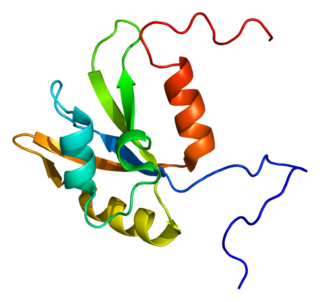
Heterogeneous nuclear ribonucleoprotein F is a protein that in humans is encoded by the HNRNPF gene.

Cleavage stimulation factor 64 kDa subunit is a protein that in humans is encoded by the CSTF2 gene.
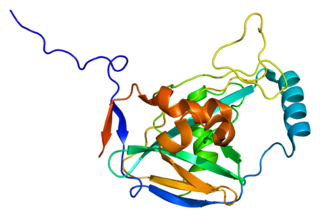
Cleavage and polyadenylation specificity factor subunit 5 (CPSF5) is an enzyme that in humans is encoded by the NUDT21 gene. It belongs to the Nudix family of hydrolases.

Cleavage and polyadenylation specificity factor subunit 1 is a protein that in humans is encoded by the CPSF1 gene.

Poly(A) polymerase alpha is an enzyme that in humans is encoded by the PAPOLA gene.

Cleavage stimulation factor 50 kDa subunit is a protein that in humans is encoded by the CSTF1 gene.

Cleavage stimulation factor 77 kDa subunit is a protein that in humans is encoded by the CSTF3 gene.
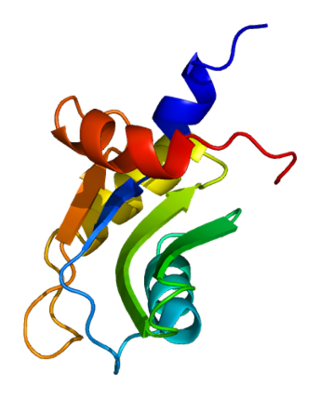
Cleavage stimulation factor 64 kDa subunit, tau variant is a protein that in humans is encoded by the CSTF2T gene.

Cleavage and polyadenylation specificity factor subunit 3 is a protein that in humans is encoded by the CPSF3 gene.

Cleavage and polyadenylation specificity factor subunit 4 is a protein that in humans is encoded by the CPSF4 gene.

Cleavage and polyadenylation specificity factor subunit 6 is a protein that in humans is encoded by the CPSF6 gene.

Integrator complex subunit 11 is a protein that in humans is encoded by the CPSF3L gene.

Poly(A) polymerase gamma is an enzyme that in humans is encoded by the PAPOLG gene.

Cleavage and polyadenylation specificity factor subunit 7 is a protein that in humans is encoded by the CPSF7 gene.
